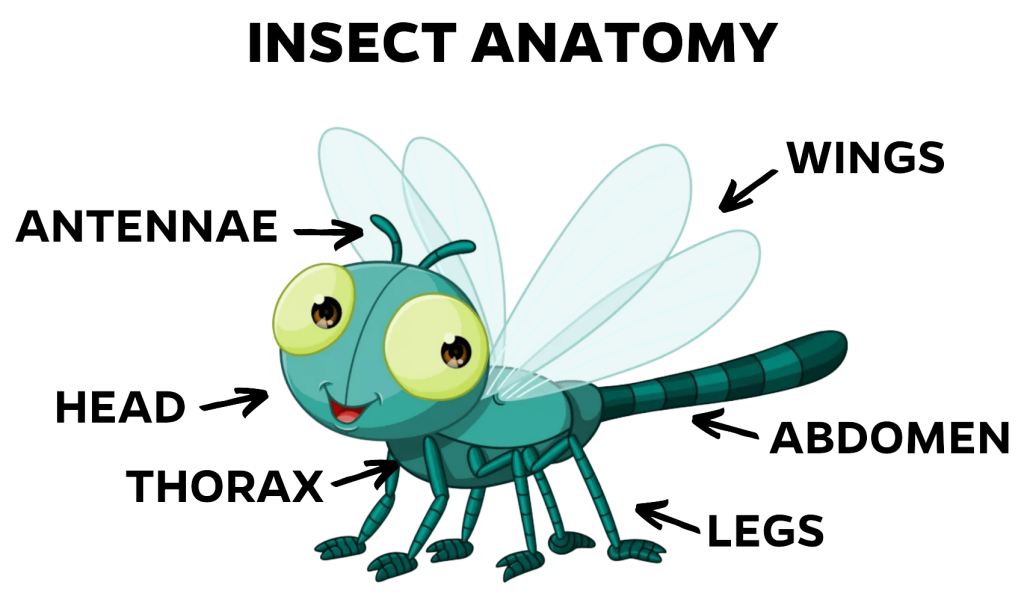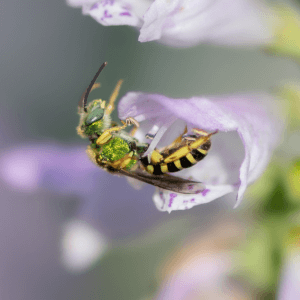There are more than 12,500 species of insects…in Florida, alone! For the average person, it can be difficult to distinguish between common, garden-variety ladybugs. And, it can be just as difficult to understand the difference between a “good” and “bad” bug. Barring a global catastrophe, our outdoor landscapes will always be home to these six-legged critters. So, it is important to take the time to get to know them better.
Continue reading to learn more about what classifies as an insect, how they grow from egg to adult, how and what they eat, plus some common pests and beneficials here in Sarasota County.
Insect Anatomy

What exactly makes an insect an insect?
Here are some common characteristics:
- Three body segments (head, thorax, abdomen)
- Six legs (paired and jointed)
- Wings (two or four)
- Exoskeleton (provides structure and protection)
- Digestive, circulatory, and nervous system
- Breathe by gills, trachea, or spiracles
Note that nature always has at least one exception to the rule, but these apply to the vast majority of species.
Insect Life Cycles
There are two main types of insect life cycles: complete and incomplete metamorphosis.
Complete Metamorphosis

In complete metamorphosis, insects go through four distinct life stages. Some examples include butterflies, beetles, bees, wasps, ants, and flies. Pictured below are the life stages of a monarch butterfly!
Incomplete Metamorphosis

In incomplete metamorphosis, insects go through three distinct life stages. Some examples include grasshoppers, crickets, dragonflies, cicadas, termites, cockroaches, and mantids. Pictured below are the life stages of a lubber grasshopper!
Both nymphs and larvae will go through several molts before reaching their next stage of development. The form they take in between molts is called an instar. It’s important to understand what the life stages of different insects look like, because pest management is often easier during the egg, nymph, or larval stages.
How Insects Feed
Insects feed…with their mouths! Shocking, I know. Try to contain yourself. Now, insects can have different kinds of mouthparts depending on what they eat. All five main mouthparts can be found below, along with an example insect.
 Siphoning mouthparts
Siphoning mouthpartsExample: Sulphur butterfly sucks up liquid nectar from thistle flower with its straw-like proboscis
 Sponging mouthparts
Sponging mouthpartsExample: Fly uses its sponging mouthparts to suck up liquid fruit juice
 Piercing-sucking mouthparts
Piercing-sucking mouthpartsExample: Aphids are using their piercing-sucking mouthparts to pierce a stem and drink sugary phloem from the plant
 Chewing mouthparts
Chewing mouthpartsExample: Lubber grasshopper uses its chewing mouthparts to rip and chew solid leaves on a plant
 Rasping-sucking mouthparts
Rasping-sucking mouthpartsExample: Onion thrip uses its rasping-sucking mouthparts to scrape plant tissue and drink the released sugary phloem
Landscape pests, in particular, tend to have either chewing, piercing-sucking, or rasping-sucking mouthparts. Signs of feeding will differ by species, but you can see some examples of insect plant damage by visiting this page.
Pest Insects
Less than 1% of all insect species are considered pests. The rest are either beneficial or harmless, still serving a purpose in our ecosystem at large. That said, certain species have earned a reputation for causing significant damage to landscape plants. The list below is certainly not exhaustive, but it includes some of the most reported pests at our Plant Clinic. Please note that for some broader categories (example: thrips), not every species is considered a pest. Make sure to apply treatment, when needed, judiciously.
Click on the insect to learn more.
 Eastern lubber grasshopper (Romalea microptera) (Credit: Andy Croatman)
Eastern lubber grasshopper (Romalea microptera) (Credit: Andy Croatman) Mealybugs (Pseudococcidae) (Credit: Jackie Lebouitz, UF/IFAS)
Mealybugs (Pseudococcidae) (Credit: Jackie Lebouitz, UF/IFAS) Thrips (Thysanoptera)
Thrips (Thysanoptera) Lobate lac scale (Paratachardina pseudolobata) (Credit: Lyle Buss, UF/IFAS)
Lobate lac scale (Paratachardina pseudolobata) (Credit: Lyle Buss, UF/IFAS) Chinch bugs (Blissus insularis) (Credit: Lyle Buss, UF/IFAS)
Chinch bugs (Blissus insularis) (Credit: Lyle Buss, UF/IFAS) Snowbush spanworm (Melanchroia chephise) (Credit: Laura Shoemaker)
Snowbush spanworm (Melanchroia chephise) (Credit: Laura Shoemaker) Mole cricket (Gryllotalpidae) (Credit: Lyle Buss, UF/IFAS)
Mole cricket (Gryllotalpidae) (Credit: Lyle Buss, UF/IFAS)Beneficial Insects
There are many, many beneficial insects working hard to provide us with important and valuable ecosystem services, such as pest management, pollination, nutrient cycling, and food for countless wildlife. When encountered, they should be left alone to do their “jobs.” Be cautious when applying broad-spectrum insecticides, even if they are low-impact, to areas that have beneficial insects present. The list below only represents a small number of the beneficial insects that can be found in Sarasota County.
Click on the insect to learn more.
 Chalcidid wasp (Conura spp.) (Credit: Lyle Buss, UF/IFAS)
Chalcidid wasp (Conura spp.) (Credit: Lyle Buss, UF/IFAS) Predatory stinkbug (Alcaeorrhynchus grandis) (Credit: Lyle Buss, UF/IFAS)
Predatory stinkbug (Alcaeorrhynchus grandis) (Credit: Lyle Buss, UF/IFAS)Insect Identification Services
Not sure if the insect in your yard is a “friend” or “foe”? Sarasota County residents can submit photos through our online form or bring a physical sample to our office at UF/IFAS Extension Sarasota County.
Submit a sample online: tiny.cc/ufsaraext_plantpest
Upcoming Classes
If you’d like to learn more about the interesting world of insects, consider perusing our Eventbrite collection: tiny.cc/ufsaraext_ebcite.
Sarasota County Starter Kit
This blog is part of our Sarasota County Starter Kit series. Visit our webpage to learn more about the program and view past recordings of webinars relevant to new residents of Sarasota County.
 6
6
 Red imported fire ant (Solenopsis invicta)
Red imported fire ant (Solenopsis invicta) Aphids (Aphidoidea)
Aphids (Aphidoidea) Whiteflies (Aleyrodidae)
Whiteflies (Aleyrodidae) Oleander caterpillar (Syntomeida epilais)
Oleander caterpillar (Syntomeida epilais) Mosquito (Culicidae)
Mosquito (Culicidae) Green lacewing (Chrysopidae)
Green lacewing (Chrysopidae) Ladybug larva (Coccinellidae)
Ladybug larva (Coccinellidae) Big-eyed bug (Geocoris spp.)
Big-eyed bug (Geocoris spp.) Minute pirate bug (Orius spp.)
Minute pirate bug (Orius spp.) Gulf fritillary (Agraulis vanillae)
Gulf fritillary (Agraulis vanillae) Zebra longwing (Heliconius charithonia)
Zebra longwing (Heliconius charithonia) Sweat bee (Halictidae)
Sweat bee (Halictidae) Hoverfly (Syrphidae)
Hoverfly (Syrphidae) Goldenrod beetle (Chauliognathus pensylvanicus)
Goldenrod beetle (Chauliognathus pensylvanicus) Carolina mantis (Stagmomantis carolina)
Carolina mantis (Stagmomantis carolina)